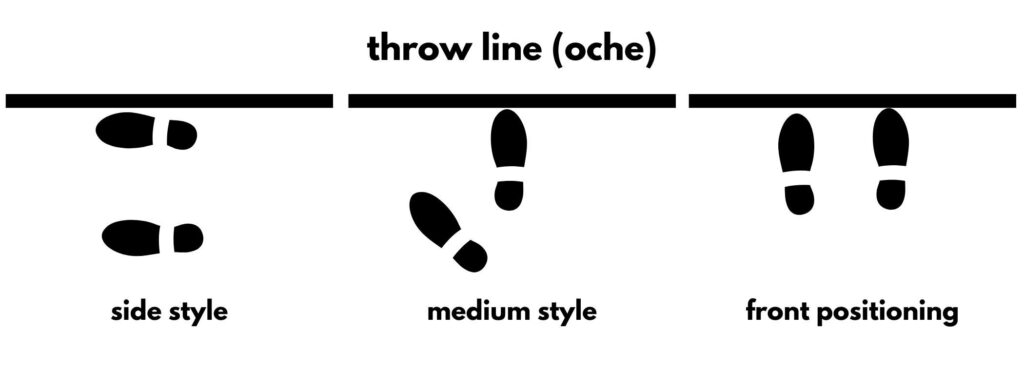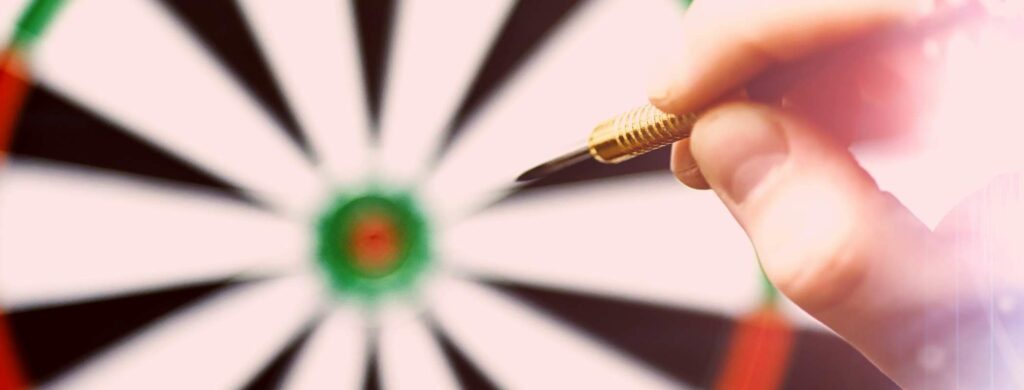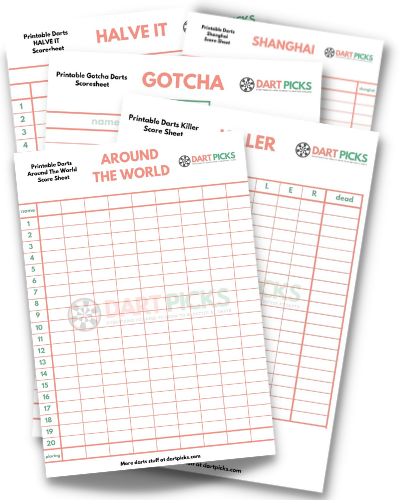We’ve done our research on some great tips for beginners on how to win at darts. Everything from your stance to your grip, we’ll take you through all the expert advice to help you find what works for you.
Darts is an ancient pastime with origins in England around the 1600s and is now widely played throughout the US and the rest of the world. Although there are various types of darts you can play, regardless of which type you’re playing, we have some great advice to help you improve.
Table of Contents
Top Tips from Experts To Win Darts
Stance
How you stand when you throw darts has a significant impact on your technique. The reasons why it’s best to find your preferred stance are twofold:
- A good stance will be balanced and familiar and allow you to perform at your best.
- Having the consistency of always using the same stance is vital to help you improve. By illiminating variables in your darts throw, you should see more consistency.

Above are the various stance types. As a beginner, it’s important to at least try them all as you may be surprised at which you find the most comfortable and consistent.
As a more experienced player, having a stance that you can reproduce over and over is vital for consistency. Remember to try out different stances with various angles. For eg, if you’ve realized that medium style is for you, check how you throw from the middle of the oche, to the left, and to the right. You may find that from one of these angles you have more success.
Most importantly, you must be comfortable. Don’t lean too far forward (though it may be tempting to reach closer to the board) because you need to be balanced so you can hold your body still.
Things we want to avoid:
- Using a different stance each time you throw
- Leaning too far forward
- Moving your feet when throwing
- Stepping over the line
The Grip

The most common way to hold a dart is the pencil or precision grip. Essentially using your thumb, index finger, and middle finger. Your thumb and index finger are the main control and your middle finger is the support.
Things to avoid:
- Flicking the dart
- Spinning the dart
- Holding the dart too tight
Holding the dart too tight is a common mistake in beginners. Think of how you would grip a pencil when lightly coloring in – that’s about how hard you want to grip your dart. Your grip needs to be enough to control the dart, but if you hold it too tight, this can affect the dart when you release it and send it off course.
Line it Up

When presenting in front of the board to throw, prepare by raising your elbow and line it up with where you want to throw. Draw the dart back, close to your face, and using your line of sight, keeping your elbow tucked in, line up the dart with your target.
Keep Your Body Still
In the world of skill science, the good news is, dart-throwing is what they call a ‘closed’ skill. That means that there are very few external factors that can act as variables on your throw. For example, because darts are played indoors, the wind is not something you have to worry about.
Closed skills are interesting because essentially, they are pretty much all down to you. How you move and coordinate movement is the biggest factor that will determine your success in darts.
If your body is moving around when you throw, all this does is add another variable to your throw. By keeping still you illuminate more variables so you can keep as consistent as possible.
Lock Your Wrist
When you throw a ball your wrist plays a big part. The most effective throws involve your whole body…and that includes your wrist. Drawing back and moving forward with the ball before you release it.
However, a dart is very different from a ball. We don’t want it to spin. The flight should be as straight as possible. As your wrist draws back, try to keep it there and use your elbow for the power of your throw.
By keeping your wrist locked, you again minimize the involvement of moving body parts as you throw your darts. Not only does this give you more control, but also consistency.
Strong Release
When it comes time to actually throwing, all the power should come from the extension of your elbow. Focus on keeping everything else still – particularly your shoulder.
Having a strong quick elbow movement will help you get the dart where you want it to go.
Avoid:
- Soft throws – flight path of the dart will drift downwards.
- Don’t throw too hard. You’ll know if you’re thorwing too hard if your dart ends up higher than you intended or your throw is too fast and you lose control sending the dart way off target.
If you watch professional darts players, they all have strong, direct throws. Try to emulate this.
Follow Through
Beginners often overlook the follow-through when throwing. By making sure to follow through, you are giving the dart the best chance of hitting your desired target as you are influencing the flight path for longer.
You should follow through with your arm and fingers pointing directly at your target.
Know the Rules
Knowing the rules in advance of playing will help you move easily through the game and also form the best strategy to win.
The best way to learn how to play darts is to play with someone who knows how to play and ask lots of questions. By actually playing, you will learn much faster as most people learn particularly well from doing rather than listening or watching.
Practice, Practice, Practice
By practicing your technique regularly it will become second nature. When you can establish a level of consistency in your technique, it leaves you to focus on your aim and game strategy.
You have to practice at anything to get better at it and darts is no exception. The best way to do this is to have a darts set up at home. Check out these boards that might do the job:
Last update on 2025-12-28 / Affiliate links / Images from Amazon Product Advertising API
If you need help with how to set up a dartboard at home try this article.
Breathing
Like any shooting event, whether it’s guns or darts, the less movement the better. Try to hold your breath at the moment you release the dart. This will not only minimize any movement from your torso during your throw but also acts as a great reminder that you should be keeping the rest of your body as still as possible when throwing.
Mindset
So often overlooked, but such a huge part of the professional darts game for most players. Before you throw, try picturing in your head the exact action and you successfully hit your target.
The mind is a powerful thing and visualizing the action from start to finish while seeing yourself in your mind’s eye being successful is a technique that athletes use to help them perform better. Sports psychology is a thing now and often a vital part in a sports competitive environment.
This can also help with confidence. Being confident when throwing will also help you get better.
Last update on 2025-12-28 / Affiliate links / Images from Amazon Product Advertising API
What if These Tips Don’t Work?
At the end of the day, if you are successfully throwing darts on target and not following any of these tips – that’s okay! In fact, some of the best darts players in the world have unusual techniques that work. One of the best examples of this is Eric Bristow.
Eric Bristow was a professional English darts player who dominated the sport in the 1980s. World Champion 5 times he was hugely successful and played a large part in raising the popularity of the game as a spectator sport with his lively personality and elite level of play.
With regards to his throwing technique, it was extremely unorthodox as he used lots of wrist flick in his throw. But he made it work!
For me, I have the habit of spinning the dart when I throw it. I tried for a long time to correct it…but in the end found that I just had more success when I spin the darts, and I also enjoy throwing that way! So, spins it is. The most important thing is you find what works for you and practice it.
Final Words
Remember, these tips are suggestions to help you improve your game based on the physics and biomechanics of dart-throwing but they are not the only good way to throw darts. Hopefully, we’ve helped point you in the direction of improving your dart game.
Check our guide on cheap dartboards if you want to try a home setup.
Last update on 2025-12-27 / Affiliate links / Images from Amazon Product Advertising API
Alex Cooper is the editor of this website. He loves darts and helping people. Alex started playing darts at the young age of 10, as his father was also a keen darts player, and has loved it ever since. Alex enjoys writing about darts and helping others learn more about the sport.
The easy way to keep track of your score is with our printable darts scoresheets. Easy to download and keep on your phone or computer or print straight off from our website. Pop your email address into the box and we'll send them straight to you.













